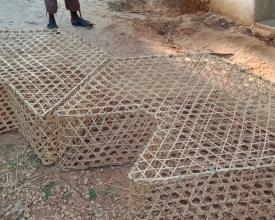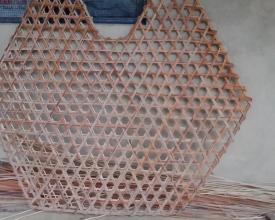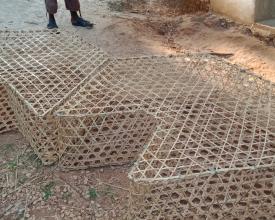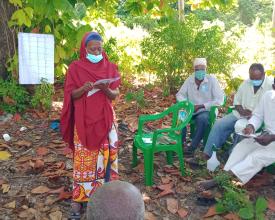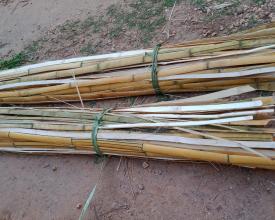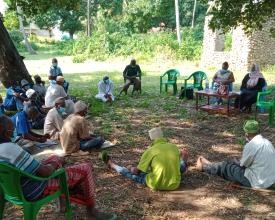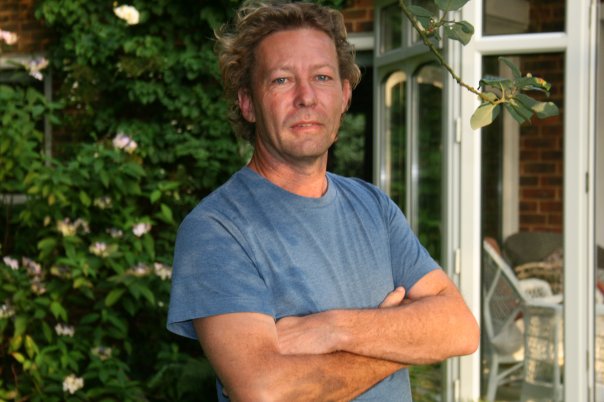
Pesca sostenible con trampas de cesta: adopción de trampas de cesta modificadas en la zona pesquera de Mkungunii, en la costa sur de Kenia.

La Unidad de Gestión de Playas de Mkunguni (BMU) se encuentra en el subcondado de Msambweni del condado de Kwale, en la costa sur de Kenia. La pesca artesanal es la principal actividad económica en la zona de cogestión de Mkunguni y las prácticas pesqueras ilegales están restringidas por la BMU. Los pescadores utilizan embarcaciones rudimentarias y artes de pesca tradicionales. Las artes artesanales utilizadas, incluidas las trampas de cesta conocidas localmente como "malema", capturan grandes proporciones de juveniles de especies objetivo y no objetivo, lo que afecta a la sostenibilidad de la pesquería y a los medios de subsistencia de la comunidad local. Las cestas trampa son las artes de pesca más utilizadas en la zona.
Para solucionar este problema, se modificaron las trampas de cesta tradicionales de 2,5 pulgadas a mallas de 3 pulgadas y se probaron con algunos pescadores de trampas de cesta en la zona de pesca de Mkunguni. El uso de las trampas de cesta modificadas redujo la captura de juveniles de las especies objetivo, aumentó las tasas de captura y, en consecuencia, los ingresos de los pescadores.
Contexto
Défis à relever
Como la mayoría de las zonas costeras, la comunidad de Mkunguni depende en gran medida de la pesca de bajura. La pesquería se enfrenta a la degradación de los hábitats marinos y el agotamiento de las poblaciones de peces debido al uso de artes destructivas e ilegales, la sobrepesca, la falta de buques pesqueros modernos para acceder a las zonas de alta mar y los efectos negativos del cambio climático, que reducen las capturas y, en consecuencia, los ingresos de los pescadores. El uso de cestas trampa modificadas se identificó como una solución para reducir el uso de artes insostenibles que capturan altas proporciones de juveniles de especies objetivo y no objetivo y aumentar los ingresos de los pescadores. Conseguir que los pescadores con trampas de cesta participaran en el ensayo fue un reto debido a la percepción de una posible disminución de las capturas por el uso de trampas de cesta de mayor tamaño de malla. Se empleó un enfoque participativo para involucrar a los pescadores, los líderes locales y las instituciones líderes en el diseño conjunto de la intervención con trampas de cesta.
Ubicación
Procesar
Resumen del proceso
La inclusión de todos los actores durante una intervención es un aspecto crítico a tener en cuenta. El diseño del proyecto orientado a la modificación de las artes existentes fue una forma de incorporar los conocimientos indígenas tradicionales al reto perpetuo de la captura de juveniles. La fase de prueba mejoró la comprensión de las repercusiones de los distintos tamaños de malla de las trampas de cesta en el ecosistema y la captura de peces. La participación ayudó a establecer un elemento de sostenibilidad y apropiación. Las intervenciones generaron beneficios económicos, que superaron el capital inicial tanto para las pruebas como para la adopción.
Bloques de construcción
Ensayo y ampliación de trampas de cesta modificadas
Llevamos a cabo una serie de reuniones de concienciación y sensibilización con los pescadores de trampas de cesta y la comunidad sobre las repercusiones de las artes de pesca destructivas en los ecosistemas y los medios de subsistencia. La recomendación fue modificar las trampas de cesta tradicionales con mallas de 2-3 pulgadas. Antes de las pruebas, diseñamos las trampas junto con los pescadores voluntarios. Dieciséis pescadores se ofrecieron voluntarios para probar las trampas modificadas. Pescadores formados y otros miembros de la comunidad recogieron datos sobre los peces a lo largo del ensayo. Utilizamos los datos para evaluar la composición de las capturas, la estructura de tamaños de los peces capturados, la retención de juveniles, la captura por unidad de esfuerzo (CPUE) y los ingresos de los pescadores. A partir de los datos, las trampas modificadas se consideraron beneficiosas desde el punto de vista económico y ecológico, y todos los pescadores de las trampas de cesta manifestaron su interés por empezar a utilizarlas. Esto condujo a la fase de ampliación, en la que se facilitó a los pescadores la construcción de las trampas de cesta modificadas.
Factores facilitadores
- Programas de sensibilización y concienciación
- Fomento de la investigación participativa
- Creación de capacidad en la construcción de cestas trampa
- Uso de los conocimientos tradicionales locales en la construcción de artes
Lección aprendida
- Las iniciativas comunitarias de conservación deben implicar activamente a la comunidad en la planificación, el diseño, la ejecución y los debates sobre los avances.
- Es importante educar a la población local sobre los efectos de los métodos de pesca insostenibles.
- Hacer que los pescadores construyeran las trampas era una garantía de trampas de buena calidad.
- Cuando los beneficiarios comprenden los problemas, participan en la creación de soluciones y recopilan datos para demostrar si el remedio sugerido es eficaz, las intervenciones recomendadas se aceptan más fácilmente.
Recursos
Financiación sostenible
Resolvimos el problema de las limitaciones financieras animando a los pescadores a unirse a grupos de ahorro. Los pescadores han formado Asociaciones de Ahorro y Préstamo de Aldea (VSLA) con el objetivo de ahorrar parte de sus ingresos y acceder a préstamos con facilidad. Formamos a los grupos sobre cómo gestionar la VSLA, también conocida como banca de mesa, así como sobre gestión financiera y dinámica de grupo, y les proporcionamos los insumos necesarios, como libros de registro. Los miembros de la VSLA celebran reuniones semanales, en las que aportan ahorros y los que necesitan préstamos los solicitan, indicando claramente el modo de devolución, el uso del préstamo y el plazo de devolución. Los pescadores son ahora capaces de satisfacer sus necesidades diarias durante la temporada del Monzón del Sureste (SEM), cuando no hay pesca debido a las duras condiciones meteorológicas. Dedican tiempo a construir y reparar las cestas-trampa para prepararse para la temporada alta del Monzón del Nordeste (NEM), cuando pueden salir a pescar.
Factores facilitadores
- La existencia de un banco de mesa similar en la Unidad de Gestión de Playas (BMU), realizado por mujeres a través de un proyecto financiado por el PNUMA, se utilizó como un buen ejemplo, ya que habían hecho progresos significativos y admirables. Esto las motivó a formar también sus propios grupos de bancos de mesa, en los que ahorrarán sus ingresos procedentes de la pesca.
Lección aprendida
- La mayoría de los miembros de la comunidad que trabajan en pequeñas y medianas empresas necesitan facilidad para acceder a la financiación, no sólo para cubrir sus necesidades diarias, sino también para crecer económicamente y ahorrar más para el futuro. Los miembros no habían participado en un plan de ahorro de ingresos, por lo que gastaban todo su dinero sin guardar una parte para los días en los que no ganaban nada o ganaban poco.
Impactos
Beneficios ecológicos y económicos: El uso de trampas de cesta modificadas redujo el número de especies no objetivo en un 82,6%, aumentó el tamaño de los peces objetivo capturados entre un 6,3% y un 15,1%, redujo el número de individuos juveniles de las especies dominantes en un 23,7% y aumentó la tasa de capturas en un 214,1% y, en consecuencia, los ingresos de los pescadores en un 222,1%.
Se ha desarrollado una cultura del ahorro entre los pescadores, que han formado Asociaciones de Ahorro y Préstamo de Aldea (VSLA), creando sostenibilidad financiera. Con las VSLA, los pescadores ahorran parte de sus ingresos y pueden acceder a préstamos sin restricciones que utilizan para cubrir otras necesidades básicas, como las matrículas escolares, construir y reparar sus casas, comprar artículos domésticos y abrir y ampliar otros negocios. También están cubiertos durante la temporada baja del Monzón del Sureste (SEM), cuando el mar está agitado y la pesca es difícil.
Beneficiarios
Pescadores, mujeres, comerciantes de pescado y jóvenes.
Objetivos de Desarrollo Sostenible
Historia
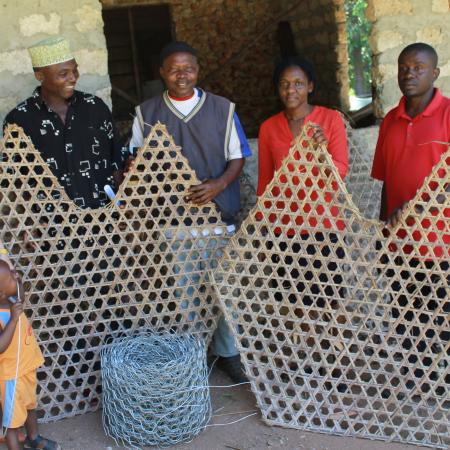
La pesca contribuye en gran medida al bienestar de las comunidades locales, que dependen de los recursos para su subsistencia. Los pescadores con nasas han utilizado tradicionalmente trampas de malla pequeña, de menos de 2,5 pulgadas, para pescar. Sin embargo, se sabe que estas trampas capturan una elevada proporción de juveniles, lo que contribuye a la sobrepesca. Hamza, de 35 años, pescador de cestas trampa en Mkunguni, dice que lleva más de 20 años pescando. A lo largo de los años, ha observado un descenso de las capturas y un aumento de la degradación de los hábitats debido al uso de métodos de pesca destructivos. Se ofreció voluntario para participar en los ensayos de las trampas cesta modificadas y supervisó su construcción. Fue pionero en la formación de un grupo VSLA en el que participan 70 pescadores de trampas de cesta y actualmente es el presidente de uno de los grupos. Dice que el grupo le ha ayudado a aprender la importancia de ahorrar parte de sus ingresos y que, cuando surge la necesidad, tiene fácil acceso a préstamos sin restricciones sobre sus ahorros. Gracias a los préstamos del grupo, ha emprendido otras actividades generadoras de ingresos, como la horticultura, que practica durante la temporada baja del Monzón del Sureste (SEM), cuando no pesca, para asegurarse un flujo constante de ingresos. Otros pescadores, como Hamza, han llevado a sus hijos a mejores escuelas, han ampliado sus negocios, han terminado de construir y amueblar sus casas y han comprado bienes. Esto ha sido posible gracias a los mejores ingresos generados por la pesca con trampas de cesta modificadas y a una mejor cultura del ahorro por parte de los pescadores. Al poder ganarse la vida y contribuir al mismo tiempo a la conservación de los ecosistemas, los pescadores han desarrollado un sentido de propiedad y responsabilidad sobre los recursos de los que dependen.
